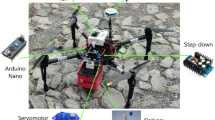Abstract
The road transport of dangerous goods has been the subject of research with increasing frequency in recent years. Global positioning system (GPS) based vehicle location devices are used to track vehicles in transit. However, this tracking technology suffers from inaccuracy and other limitations. In addition, real-time tracking of vehicles through areas shielded from GPS satellites is difficult. In this paper, the authors have addressed the implementation of a smart vehicle navigation system capable of using radio frequency identification based on information about navigation paths. For prediction of paths and accurate determination of navigation paths in advance, predictive algorithms have been used based on the hidden Markov model. At the core of the system there is an existing field programmable gate array board and hardware for collection of navigation data. A communication protocol and a database to store the driver’s habit data have been designed. From the experimental results obtained, an accurate navigation path prediction is consistently achieved by the system. In addition, once-off disturbances to the driver habits have been filtered out successfully.
















Similar content being viewed by others
References
Ning, Y., Zhong-qin, W., Malekian, R., Ru-chuan, W., & Abdullah, A. H. (2013). Design of accurate vehicle location system using RFID. Electronics & Electrical Engineering, 19(8), 105–110.
Tebaldi, C., & West, M. (1998). Bayesian inference on network traffic using link count data. Journal of the American Statistical Association, 93(442), 557–573.
Prins, C. (2004). A simple and effective evolutionary algorithm for the vehicle routing problem. Computers & Operations Research, 31(12), 1985–2002.
Baker, B. M., & Ayechew, M. A. (2003). A genetic algorithm for the vehicle routing problem. Computers & Operations Research, 30(5), 787–800.
Baum, L. E., Petrie, T., Soules, G., & Weiss, N. (1970). A maximization technique occurring in the statistical analysis of probabilistic functions of Markov chains. The Annals of Mathematical Statistics, 41, 164–171.
Sonnhammer, Erik L. L., Heijne, Gunnar V., & Krogh, A. (1998). A hidden Markov model for predicting transmembrane helices in protein sequences. Ismb, 6, 175–182.
Stanke, M., & Waack, S. (2003). Gene prediction with a hidden Markov model and a new intron submodel. Bioinformatics, 19, 215–225.
Ning, Y., Zhong-qin, W., Malekian, R., Qiaomin, L., & Ru-chuan, W. (2015). A method for driving route predictions based on hidden Markov model. Mathematical Problems in Engineering, 2015, 1–12.
Barth, M., & Karbassi, A. (2003). Vehicle route prediction and time of arrival estimation techniques for improved transportation system management.” Intelligent vehicles symposium, (pp. 511–516).
Froehlich, J., & Krumm, J. (2008). Route prediction from trip observations. SAE Technical Paper No. 2008-01-0201.
Feng, H., Liu, C., Shu, Y., & Yang, O. W. (2015). Location prediction of vehicles in VANETs using a Kalman filter. Wireless Personal Communications, 80(2), 543–559.
De Silva, M. W. H. M., Konara, K. M. S. M., Karunarathne, I. R. A. I., Lal, K. K. U. P., & Wijesundara, M. (2014). An information system for vehicle navigation in congested road networks. PNCTM 21, 3, 113–116.
Simmons, R., Browning, B., Zhang, Y., & Sadekar, V. (2006). Learning to predict driver route and destination intent. Intelligent transportation systems conference (ITSX 06), (pp.127–132).
Ye, N., Wang, Z. Q., Malekian, R., Zhang, Y. Y., & Wang, R. C. (2015). A method of vehicle route prediction based on social network analysis. Journal of Sensors, 2015, 1–9.
Quddus, M., & Washington, S. (2015). Shortest path and vehicle trajectory aided map-matching for low frequency GPS data. Transportation Research Part C: Emerging Technologies, 55, 328–339.
Luo, W., Tan, H., Chen, L., & Ni, L. M. (2013). Finding time period-based most frequent path in big trajectory data. In Proceedings of the 2013 ACM SIGMOD international conference on management of data, (pp. 713–724).
Kansal, A., Goraczko, M., & Zhao, F. (2007). Building a sensor network of mobile phones. In Proceedings of the 6th international conference on Information processing in sensor networks(IPSN ’07), (pp. 547–548).
Author information
Authors and Affiliations
Corresponding author
Rights and permissions
About this article
Cite this article
Malekian, R., Kavishe, A.F., Maharaj, B.T. et al. Smart Vehicle Navigation System Using Hidden Markov Model and RFID Technology. Wireless Pers Commun 90, 1717–1742 (2016). https://doi.org/10.1007/s11277-016-3419-1
Published:
Issue Date:
DOI: https://doi.org/10.1007/s11277-016-3419-1




